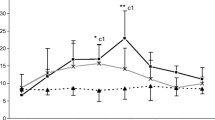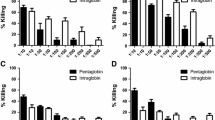Summary
In this paper we have described the microbiology of the granuloma pouch model in rats. We studied the biochemical parameters of pouch exudates infected withEscherichia coli. Data revealed that the inflammatory response increased during the course of infection since lactate dehydrogenase levels as well as α2 and γ-globulin fractions were increased in comparison to uninfected controls. Infection of the pouches did not spread. We also monitored the growth characteristics of four differentE. coli strains.In vitro incubation of these strains in human and rat serum as well as in pouch exudate, and thein vivo growth rate in infected pouches revealed that the degree of serum sensitivity was clearly related to viabilityin vivo. Serum-resistant strains grew well in pouch exudate, whereas serum-sensitive strains were eliminated from the infected pouches. Since elimination of these strains was dependent on the challenge dose, we concluded that cellular and/or humoral host defense mechanisms became locally exhausted or inactivated. Thus, the granuloma pouch represents a local bacterial infection of a poorly defended, inflamed body cavity.
Zusammenfassung
Die Mikrobiologie des „Granuloma pouch“-Modells in Ratten wird beschrieben. Biochemische Untersuchungen von Pouch-Exsudaten, die mitEscherichia coli infiziert worden waren, ergaben, daß im Verlauf der Infektion die entzündliche Reaktion gesteigert wird, da die Laktat-Dehydrogenase-Spiegel und α2-sowie γ-Globulin-Fraktionen im Vergleich zu nicht infizierten Kontrollen erhöht waren. Die Infektion generalisierte sich nicht. Die Wachstumscharakteristika von vier unterschiedlichenE. coli-Stämmen wurden aufgezeichnet. Das Wachstumsverhalten der Stämmein vitro in menschlichem oder Rattenserum sowie Pouch-Exsudat wurdein vivo in infizierten Pouchen widergespiegelt. Das Ausmaß der Serumempfindlichkeit der Stämme entsprach eindeutig denIn-vivo-Wachstumsraten; Serum-resistente Stämme wuchsenin vivo sehr gut im Pouch-Exsudat, wogegen Serum-empfindliche Stämme von den infizierten Pouchen eliminiert wurden. Da die Elimination dieser Stämme von der Infektions-dosis abhängig war, wird angenommen, daß die Bestandteile der zellulären und/oder humoralen Körperabwehr lokal „verbraucht“ oder inaktiviert werden. Somit stellt die Granuloma-Pouch eine lokale bakterielle Infektion in einer abwehrgeschwächten entzündeten Körperhöhle dar.
Similar content being viewed by others
Literature
Barza, M. A critique of animal models in antibiotic research. Scand. J. Infect. Dis. Suppl. 14 (1978) 109–117.
Rolinson, G. N. Basis and results of therapy with betalactam antibiotics in experimental infections. Infection 8. Suppl. 1 (1980) S 30-S 34.
Scheld, W. M., Sande, M. A.: Evaluation of combination antibiotic therapy in experimental animal models of infection. In:Klastersky, J. (ed.): Combinations of antibiotics. Raven Press, New York (in print).
Zak, O. Scope and limitations of experimental chemotherapy. Experientia 36 (1980) 479–483.
Dalhoff, A., Frank, G., Luckhaus, G. The granuloma pouch — anin vivo model for pharmacokinetic and chemotherapeutical investigations. I. Biochemical and histological characterization. Infection 10 (1982) 354–360.
Selye, H. Use of “granuloma pouch” technique in the study of antiphlogistic corticoids. Proc. Soc. Exp. Biol. Med. 82 (1953) 328–333.
Taylor, P. W., Roberts, A. P., Gower, P. E. Evaluation of a technique for the estimation of serum bactericidal activity against gram-negative organisms. Med. Lab. Technol. 29 (1972) 272–279.
Undeutsch, C., Brunner, H. Einfluß von Antikörpern auf die Phagocytose vonKlebsiella penumoniae durch Alveolarmacrophagen. Zbl. Bakt. Hyg. I Abt. Orig. A 249 (1981) 43–52.
Fearon, D. T., Ruddy, S., Schur, P. H., McCabe, W. R. Activation of properdin pathway of complement in patients with gramnegative bacteremia N. Engl. J. Med. 292 (1975) 937–940.
Walter, M. IgG hydrolysis in abscesses. I. A study of the IgG in human abscess fluid. Immunology 26 (1974) 725–735.
Plant, A. G., Wistar, R., Capra, J. D. Differential susceptibility of human IgA immunoglobulins to streptococcal IgA protease. J. Clin. Invest. 54 (1974) 1295–1300.
Lew, D. P., Zubler, R., Vaudaux, P., Farquet, J. J., Waldvogel, F. A., Lambert, P. H. Decreased heat-labile opsonic activity and complement levels associated with evidence of C3 breakdown products in infected pleural effusions. J. Clin. Invest. 63 (1979) 326–334.
Lew, D. P., Despont, J. P., Perrin, L. H., Aguado, M. T., Lambert, P. H., Waldvogel, F. A. Demonstration of a local exhaustion of complement components and of an enzymatic degradation of immunoglobulins in pleural empyema: a possible factor favouring the persistence of local bacterial infections. Clin. Exp. Immunol. 42 (1980) 506–514.
Eisler, D. M., von Metz, E. K. Anti-Pasteuella pestis factor in organs of normal mice and guinea pigs. I. Biologic Characterization. J. Immunol. 91 (1963) 287–294.
Eisler, D. M., Hill, B., von Metz, E. K., Chang, W. J., Heckley, R. J. Anti-Pasteurella pestis factor from mice and guinea pigs. II. Some chemical and physical characteristics. J. Immunol. 98 (1967) 576–583.
Eisler, D. M., von Metz, E. K. Anti-Pasteurella pestis factor. III. The effect of fatty acids onPasteurella pestis. J. Bacteriol. 95 (1968) 1767–1773.
Kochan, B., Golden, C. A. Antimycobacterial effect of lysates prepared from immunologically activated macrophages. Infect. Immun. 8 (1973) 388–394.
Kochan, J., Golden, C. A. Immunological nature of antimycobacterial phenomenon in macrophages. Infect. Immun. 9 (1974) 249–254.
Kochan, J., Pellis, N. R., Pfohl, D. C. Effects of normal and activated cell fractions on the growth of tubercle bacilli. Infect. Immun. 6 (1972) 142–148.
Sheu, C. W., Freese, E. Lipopolysaccharide layer protection of gram-negative bacteria against inhibition by long-chain fatty acids. J. Bacteriol. 115 (1973) 869–875.
Dye, E. S., Kapral, F. A. Partial characterization of a bactericidal system in staphylococcal abscesses. Infect. Immun. 30 (1980) 198–203.
Dye, E. S., Kapral, F. A. Characterization of a bactericidal lipid developing within staphylococcal abscesses. Infect. Immun. 32 (1981) 98–104.
Author information
Authors and Affiliations
Rights and permissions
About this article
Cite this article
Dalhoff, A., Frank, G. & Luckhaus, G. The granuloma pouch: An in vivo model for pharmacokinetic and chemotherapeutic investigations. II. Microbiological characterization. Infection 11, 41–46 (1983). https://doi.org/10.1007/BF01651357
Received:
Accepted:
Issue Date:
DOI: https://doi.org/10.1007/BF01651357




